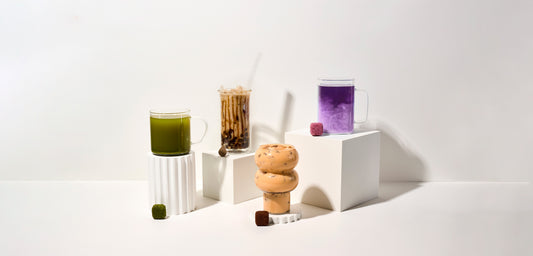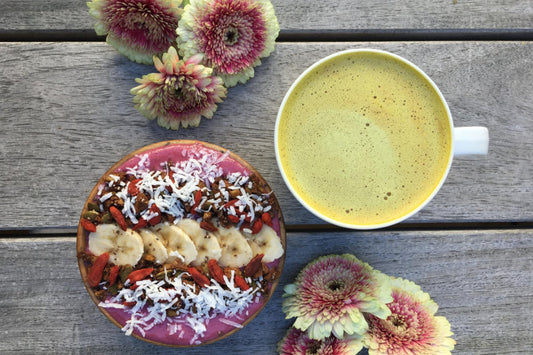
Sweet, fragrant, and forever soothing, lavender is one of the loveliest scents in the world. Just the very word conjures perfumed fields painting pretty Provence purple. Anyone who has had the pleasure of inhaling deep around lavender knows its instantly soothing effect. This is the reason it's distilled down into essential oils, crushed into beauty products, and even turned into culinary products like tea. Lavender tea is lush stuff. Not only is it deliciously caffeine-free and gloriously aromatic, but it also comes with a heap of health properties too. Let’s take a look at all the lavender tea benefits and get you brewing up a floral cup of goodness.
What Is Lavender Tea?
Lavender tea is made from buds of the lavender flower steeped in hot water. It is a tisane or herbal tea as it doesn’t come from the camellia sinensis plant. The lavender plant is known as lavandula angustifolia and is commonly found in Mediterranean climates.
Purple and violet and with an unmistakable scent, lavender is one of the world’s favorite herbs. For centuries lavender has been used in aromatherapy and healing thanks to its calming effect and ability to shut out anxiety and take away pain. While it wasn’t as commonly used in drinking form in comparison to other flowers like chamomile, it was definitely a must for any medieval medicine cabinet. Lavender also comes from the same family as mint and sage, also known as the Lamiaceae botanical family.
Lavender makes a delicious addition to tea as it brings with it that earthly sweet aroma, a hint of rosemary, and even notes of mint or apple or any other treasures carried in with the wind. Lavender is often found as an ingredient mixed into other tea blends – especially teas that tend to be targeted at helping people wind down and relax or as a beautiful bedtime brew. But you can also drink lavender tea without any additional flavors involved and just enjoy the pure lilac-colored flower completely on its own.
While France is the place most synonymous with lavender, this robust and sweet bush pops up all over Europe and beyond. There are actually around 39 different kinds of lavender scattered across the globe however not all of them are edible and made for consumption. Lavender from the Provence area of France is considered to be the best in the world as the southern weather provides perfect growing conditions for this aromatic herb to thrive.
Mother nature can be a magical medicine cabinet stuffed full of good stuff and lavender tea is certainly part of this mix. Not only will this fragrant floral treat deliver a deeply calming effect and help you to leave sleepless nights behind but it can help your skin to heal, reduce inflammation and pain, and even keep your immune system in check. Delicious, dreamy, and delivering a bounty of health benefits, let’s take a closer look at exactly what lavender tea can do for you.
10 Health Benefits of Lavender Tea
Sleep sweet and easy, keep your skin flushed and bright, and show anxiety the door as we delve into the delights of drinking lavender tea. While more studies are needed on the ingestion of lavender in tea, there have been a ton of results showing the healing benefits of lavender as an aromatic healer so pouring a cup and letting the steam rise works wonders for your wellness journey.
Better Sleep
De-stress and sleep easy by curling up before bed with a cup of calming lavender tea. A steaming cup of lavender has long been used to treat sleep disorders as the aromatic herb helps to calm brain function all by triggering a response in your nervous system. Studies have shown that new mothers dealing with postpartum enjoyed better sleep quality when inhaling lavender fragrance 4 days a week for 8 weeks. While there are many anxiety-busting de-stress teas out there, lavender is believed to be one of the best.
Ease Menstrual Pain
For all those who find themselves curled up into a tight ball every month and fighting through cramps and period discomfort, lavender can be your knight in shining armor. This soothing sweet herb reduces inflammation, calms the body, and minimizes muscle spasms - all awesome traits for someone who is experiencing pain. Studies have shown that young women who inhaled the scent of lavender for 30 minutes per day during the first 3 days of their cycle experienced less pain than a control group. Next time your cycle is due, be sure to put the kettle on.
Protect Skin From Fungal Infections
There’s a reason that lavender oil is so commonly used in skincare products as the healing potency of this plant brings a bounty of health to your skin. Lavender has been shown to have anti-inflammatory and anti-fungal properties, both of which are awesome at promoting skin healing and keeping you flushed with health. This is why you always see lavender in the active ingredients list for products aimed at acne, psoriasis, and other fragile skin conditions that need a gentle healing hand.
Balance Your Immune System
There are lots of awesome teas out there that are considered immune and energy-boosting teas and lavender is one of them. Antioxidants and anti-inflammatory properties all lead to lavender being hugely beneficial for your immune system. Keeping your immune system healthy and working to the best of its ability is a surefire way of cutting down on your risks of catching illnesses and being at the top of your health game. Lavender tea is said to contain loads of vitamin C, magnesium, calcium, and a host of other nutrients that help the body to fight off all kinds of infections.
Digestive System Support
Get your digestive system into shape as you sit down to sip a nurturing cup of lavender tea. Whether you are battling bloating, nausea, stomach upset, indigestion, or cramps – lavender tea can soothe the body, reduce muscle spasms, and use that same antispasmodic magic to reduce uncomfortable gas and streamline your system. The scent of lavender is said to trigger your bile production which can help to break down food all while that calming scent can help the body hold less tension. That same calming effect can also help quell nausea as it sparks a chemical reaction in the brain. For any digestive issues that are disrupting your day, lavender herbal tea can get you back on track.
Improve Respiratory Health
Before slinging back your lavender tea, take a deep breath and let the bright and springlike aroma open all your airways. For those who struggle with breathing problems, lavender can lend a little helping hand in making life more comfortable. The antimicrobial and anti-inflammatory properties get to work on the muscles in your chest and throat, making it easier to breathe and effectively dealing with any bacteria that could be causing chesty colds, coughs, and congestion.
Ease Anxiety Symptoms
Of all the scents in the world, none can guide you back to glorious grounding and calm the senses quite like lavender. Clinical trials conducted as recently as 2020 found that drinking lavender tea as an older adult can help to ease symptoms and feelings of stress and anxiety. Lavender is said to stimulate activity in certain places of the brain, sending messages and impulses between brain cells that communicate a calm demeanor and a positive mood.
Wound Healing
Cuts, burns, and any kinds of skin blemishes and wounds will all enjoy the healing properties of lavender. This fragrant flower can help to produce collagen in the skin which encourages healing. A recent study showed that topical application of lavender oil for 14 days had a significant impact on reducing the area of the wound.
Promote Hair Growth
While more studies are needed to truly nail down these results, preliminary findings have led us to believe that lavender can help your hair to grow. For those suffering from hair loss or anyone who craves long and luscious locks, the results of lavender oil in hair growth and animal studies nod towards potential success.
Migraine Pain Relief
As lavender gets to work on reducing pain in the body, this also means it can play an important role in helping reduce headaches, muscle pain, backache, and any other issues you have going on. Essential oils have long played a role in helping to naturally treat headaches and in trials and tests, lavender didn’t skip a beat and came back as hugely beneficial in soothing an aching head.

Possible Side Effects of Lavender Tea
Lavender is considered to be generally safe and side effect free but as with all wild things, there are some people who may be susceptible to the effects of this tea.
Lavender may have hormonal effects on young prepubescent boys and pregnant women. In young boys, it can encourage breast tissue growth which will be reversed as soon as the person cuts out lavender tea. It has also been linked to mimicking the estrogen hormone so pregnant women may want to check with their medical professional first.
People who are allergic to lavender flowers should also avoid lavender tea as they may suffer side effects like a rash, throat irritation, and breathing issues.
Who shouldn’t drink lavender tea?
- Young boys
- Pregnant women
- Those who have allergic reactions to lavender
Lavender Tea: The Perfect Recipe
Lavender tea is a super easy tea to make and you can use dried flower buds or lavender plucked from a flowering plant in your garden. You should be sure to turn to fresh flowers only if you are sure they have been grown organically and come free from pesticides and herbicides.
- 8oz of water (spring is best)
- 2 tablespoons of dried lavender
- Tea infuser
- Place your lavender buds or flowers in the tea strainer and put the strainer into a cup.
- Boil your water.
- Pour the boiling water over your infuser and into the cup and let steep for 5-10 minutes. The longer you leave it steeping the stronger the lavender taste will be so adjust according to your preferences.
- Remove the strainer and enjoy!
- You can add other flavors that work well with lavender tea. Peppermint is a popular choice and with a Peppermint Tea Drop it’s as easy as can be. Simply drop your tea drop into the cup and let it melt away.
Frequently Asked Questions About Lavender Tea
Is lavender safe for tea?
Yes, lavender is safe for tea but be sure it’s a variety that can be consumed and if using fresh flowers check for organic-only to avoid pesticides and other chemicals.
How much lavender do you put in tea?
If using dried lavender buds or flowers, two tablespoons work well for an 8oz cup.
What type of lavender is good for tea?
Lavender Angustifolia is the best type of lavender to use for tea.
Does chamomile partner well with lavender tea?
Lavender and chamomile make an amazing partnership when it comes to tea. Together, these floral notes will instantly soothe the nerves, ease anxiety, and provide a gentle herbal remedy that encourages deeper sleep as they are caffeine free.
Wrap Up
Lavender tea is amazing and for those who often find themselves tied to anxiety or sleepless nights; this beautiful bright brew could be exactly what you need to get some serious R&R and boost your overall health and wellness. For centuries healers have been turning to lavender and even to this very day, we often use this floral friend in skincare tonics, beauty products, and aromatherapy. Get ready to ease all your senses with the love of lavender tea.
**Medical Disclaimer: The information in this article is for informative purposes only and shouldn’t be taken as medical advice. Those who have any health-related queries should be sure to reach out to a medical professional. These statements have not been evaluated by the Food and Drug Administration. This article is not intended to diagnose, treat, cure, or prevent any disease.









